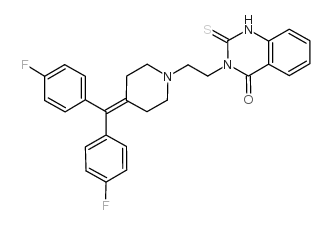R59949

R59949 structure
|
Common Name | R59949 | ||
|---|---|---|---|---|
| CAS Number | 120166-69-0 | Molecular Weight | 489.57900 | |
| Density | 1.36g/cm3 | Boiling Point | 637.1ºC at 760mmHg | |
| Molecular Formula | C28H25F2N3OS | Melting Point | N/A | |
| MSDS | Chinese USA | Flash Point | 339.1ºC | |
| Symbol |

GHS07 |
Signal Word | Warning | |
Use of R59949R59949 is a pan diacylglycerol kinase (DGK) inhibitor with an IC50 of 300 nM. R59949 strongly inhibits the activity of type I DGK α and γ and moderately attenuates the activity of type II DGK θ and κ. R59949 activates protein kinase C (PKC) by enhancing the levels of the endogenous ligand diacyl glycerol[1][2][3]. |
| Name | 3-[2-[4-[bis(4-fluorophenyl)methylidene]piperidin-1-yl]ethyl]-2-sulfanylidene-1H-quinazolin-4-one |
|---|---|
| Synonym | More Synonyms |
| Description | R59949 is a pan diacylglycerol kinase (DGK) inhibitor with an IC50 of 300 nM. R59949 strongly inhibits the activity of type I DGK α and γ and moderately attenuates the activity of type II DGK θ and κ. R59949 activates protein kinase C (PKC) by enhancing the levels of the endogenous ligand diacyl glycerol[1][2][3]. |
|---|---|
| Related Catalog | |
| In Vitro | In the presence of R59949, vasopressin- as well as collagen-induced release reaction and aggregation was strongly increased, independently of the formation of arachidonate metabolites[1]. In THP‐1 monocytes, R59949 attenuates CCL2‐evoked Ca2+ signalling with a half‐maximal concentration of 8.6 μM[2]. R59949 inhibits inducible nitric oxide production through decreasing transplasmalemmal L-arginine uptake in vascular smooth muscle cells[4]. |
| References |
| Density | 1.36g/cm3 |
|---|---|
| Boiling Point | 637.1ºC at 760mmHg |
| Molecular Formula | C28H25F2N3OS |
| Molecular Weight | 489.57900 |
| Flash Point | 339.1ºC |
| Exact Mass | 489.16900 |
| PSA | 73.12000 |
| LogP | 5.87310 |
| Vapour Pressure | 3.94E-16mmHg at 25°C |
| Index of Refraction | 1.688 |
| InChIKey | ZCNBZFRECRPCKU-UHFFFAOYSA-N |
| SMILES | O=c1c2ccccc2[nH]c(=S)n1CCN1CCC(=C(c2ccc(F)cc2)c2ccc(F)cc2)CC1 |
| Storage condition | -20°C |
| Symbol |

GHS07 |
|---|---|
| Signal Word | Warning |
| Hazard Statements | H315-H319-H335 |
| Precautionary Statements | P261-P305 + P351 + P338 |
| Personal Protective Equipment | dust mask type N95 (US);Eyeshields;Gloves |
| Hazard Codes | Xi |
| Risk Phrases | R36/37/38 |
| Safety Phrases | S26-S36 |
| RIDADR | NONH for all modes of transport |
|
Diacylglycerol kinase α promotes 3D cancer cell growth and limits drug sensitivity through functional interaction with Src.
Oncotarget 5(20) , 9710-26, (2014) Diacylglycerol kinase (DGK)α converts diacylglycerol to phosphatidic acid. This lipid kinase sustains survival, migration and invasion of tumor cells, with no effect over untransformed cells, suggesti... |
|
|
Insulin action on polyunsaturated phosphatidic acid formation in rat brain: an "in vitro" model with synaptic endings from cerebral cortex and hippocampus.
Neurochem. Res. 34(7) , 1236-48, (2009) The highly efficient formation of phosphatidic acid from exogenous 1-stearoyl-2-arachidonoyl-sn-glycerol (SAG) in rat brain synaptic nerve endings (synaptosomes) from cerebral cortex and hippocampus i... |
|
|
Effect of novel modulators of protein kinase C activity upon chemotherapy-induced differentiation and apoptosis in myeloid leukemic cells.
Anticancer Drugs 13(7) , 725-33, (2002) Modulation of protein kinase C (PKC) activity has been demonstrated to either prevent or enhance drug-induced apoptosis in various tissue types. We tested four novel modulators of PKC activity in comp... |
| MFCD00069258 |
| Diacylglycerol Kinase Inhibitor II |